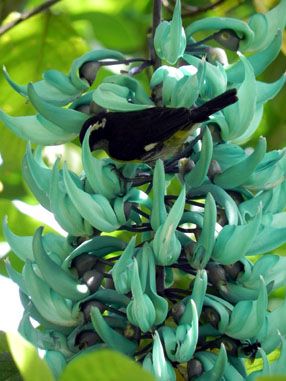The Rare Jade Vine

The Jade Vine - Strongylodon macrobotrys
A few years ago, while on a wonderful birding trip to Trinidad and Tobago, our group spent several days at the Asa Wright Nature Centre. Asa Wright is tucked into the lush tropical rainforest of the Arima Valley in Trinidad. We were fortunate to see, experience and enjoy so many breathtaking sights. We went there to see splendid tropical birds, and we did, but we saw so much more. The rainforest was so alive, verdant and beautiful.
The grounds of Asa Wright are a botanical wonderland of gorgeous flowering plants and trees. We watched as gorgeous hummingbirds visited towering torch ginger with its huge magnificent blooms. Lobster-claw Heliconia dangled their pink, green and red 2-3 foot blossoms in our faces. Everywhere one looked a plant was displaying its beauty. One of the rarest of plants we were so lucky to see, and in full bloom, was the exquisitely beautiful jade vine. Though the jade vine is not native to Trinidad it was a spectacular plant to see.
 Named for its stunning blue-green color, the jade vine is native to the Philippines. While it was once plentiful in the wild there, it is now threatened due to deforestation of its natural habitat. Over the last several decades’ vast areas of the Philippine rainforests have been destroyed. Believe it or not this exotic tropical beauty is in the same family as peas and beans (Leguminosae). It is even closely related to our familiar kidney bean and runner bean.
Named for its stunning blue-green color, the jade vine is native to the Philippines. While it was once plentiful in the wild there, it is now threatened due to deforestation of its natural habitat. Over the last several decades’ vast areas of the Philippine rainforests have been destroyed. Believe it or not this exotic tropical beauty is in the same family as peas and beans (Leguminosae). It is even closely related to our familiar kidney bean and runner bean.
The jade vine is a liana. Lianas are vine like plants that are a common sight in rainforests. These plants set seed in the ground and then grasp tree trunks and climb their way up, up and up. Lianas usually use trees for support or other vines. Their vigorous woody vines grow and stretch up towards the canopy seeking the sunlight.
While liana type vines in rainforest habitat, often contribute showy flowers with sweet nectar, fruit, and a pathway around the tree canopy for a variety of arboreal animals, some lianas can be so vigorous and aggressive they compete with trees for sunlight and nutrients and can be detrimental to the trees. An example of this you might be familiar with here in North America is how wild grape vines aggressively strangle and damage the trees they climb.
The particular vine at Asa Wright grows on a massive arbour erected just for this vine. A closer look at the vine and you can see how it could certainly grow its way to the upper most canopy of a rainforest. It snakes its way through every inch of the arbour. The blooms of this vine are simply spectacular. I’ve never seen anything like it. Huge, dangling trusses covered with luminous blue/green flowers. Individual blossoms resemble a giant claw turned upward. In the wild, bats are the main pollinator of the vine. While I visited the vine on several occasions during the daylight hours, I saw birds and bees visiting the nectar filled blossoms. This is one fabulously flamboyant flower. I’m so thrilled I had a chance to see one in bloom.
A few years ago, while on a wonderful birding trip to Trinidad and Tobago, our group spent several days at the Asa Wright Nature Centre. Asa Wright is tucked into the lush tropical rainforest of the Arima Valley in Trinidad. We were fortunate to see, experience and enjoy so many breathtaking sights. We went there to see splendid tropical birds, and we did, but we saw so much more. The rainforest was so alive, verdant and beautiful.
The grounds of Asa Wright are a botanical wonderland of gorgeous flowering plants and trees. We watched as gorgeous hummingbirds visited towering torch ginger with its huge magnificent blooms. Lobster-claw Heliconia dangled their pink, green and red 2-3 foot blossoms in our faces. Everywhere one looked a plant was displaying its beauty. One of the rarest of plants we were so lucky to see, and in full bloom, was the exquisitely beautiful jade vine. Though the jade vine is not native to Trinidad it was a spectacular plant to see.
 Named for its stunning blue-green color, the jade vine is native to the Philippines. While it was once plentiful in the wild there, it is now threatened due to deforestation of its natural habitat. Over the last several decades’ vast areas of the Philippine rainforests have been destroyed. Believe it or not this exotic tropical beauty is in the same family as peas and beans (Leguminosae). It is even closely related to our familiar kidney bean and runner bean.
Named for its stunning blue-green color, the jade vine is native to the Philippines. While it was once plentiful in the wild there, it is now threatened due to deforestation of its natural habitat. Over the last several decades’ vast areas of the Philippine rainforests have been destroyed. Believe it or not this exotic tropical beauty is in the same family as peas and beans (Leguminosae). It is even closely related to our familiar kidney bean and runner bean. The jade vine is a liana. Lianas are vine like plants that are a common sight in rainforests. These plants set seed in the ground and then grasp tree trunks and climb their way up, up and up. Lianas usually use trees for support or other vines. Their vigorous woody vines grow and stretch up towards the canopy seeking the sunlight.
While liana type vines in rainforest habitat, often contribute showy flowers with sweet nectar, fruit, and a pathway around the tree canopy for a variety of arboreal animals, some lianas can be so vigorous and aggressive they compete with trees for sunlight and nutrients and can be detrimental to the trees. An example of this you might be familiar with here in North America is how wild grape vines aggressively strangle and damage the trees they climb.
The particular vine at Asa Wright grows on a massive arbour erected just for this vine. A closer look at the vine and you can see how it could certainly grow its way to the upper most canopy of a rainforest. It snakes its way through every inch of the arbour. The blooms of this vine are simply spectacular. I’ve never seen anything like it. Huge, dangling trusses covered with luminous blue/green flowers. Individual blossoms resemble a giant claw turned upward. In the wild, bats are the main pollinator of the vine. While I visited the vine on several occasions during the daylight hours, I saw birds and bees visiting the nectar filled blossoms. This is one fabulously flamboyant flower. I’m so thrilled I had a chance to see one in bloom.

Related Articles
Editor's Picks Articles
Top Ten Articles
Previous Features
Site Map
Content copyright © 2023 by Hazel M. Freeman. All rights reserved.
This content was written by Hazel M. Freeman. If you wish to use this content in any manner, you need written permission. Contact Hazel M. Freeman for details.



